Photo
Richard Brakenburgh or Brakenburg (22 May 1650, in Haarlem – 28 December 1702, in Haarlem), was a Dutch Golden Age painter.
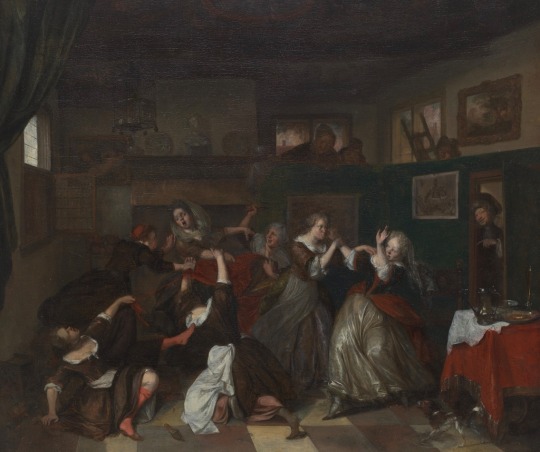
Richard Brakenburgh (1650-1702), ‘Ladies Fighting in an Interior with Others’
12 notes
·
View notes
Photo
Richard Brakenburgh or Brakenburg (22 May 1650, in Haarlem – 28 December 1702, in Haarlem), was a Dutch Golden Age painter.
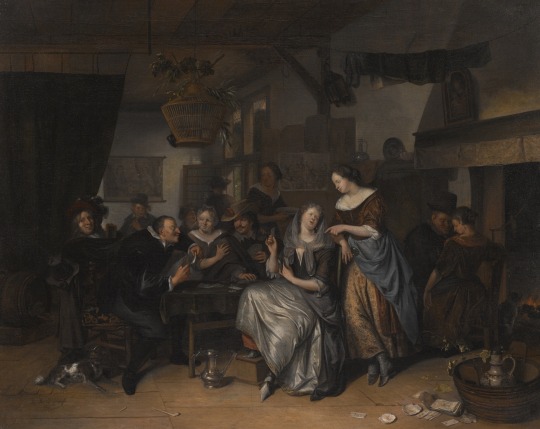
Richard Brakenburgh (1650-1702), ‘A Tavern Interior with Card Players’, 1692
10 notes
·
View notes
Photo
Richard Brakenburgh or Brakenburg (22 May 1650, in Haarlem – 28 December 1702, in Haarlem), was a Dutch Golden Age painter.
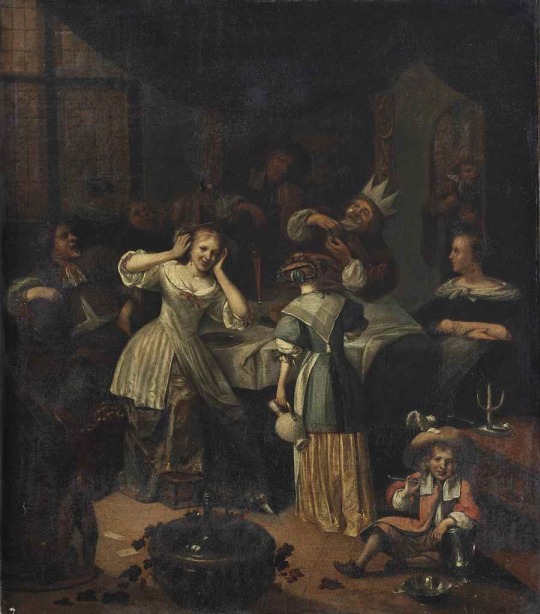
Richard Brakenburgh (1650-1702), ‘The King Drinks: the festival of the Bean King at Twelfth Night’
11 notes
·
View notes
Photo
Richard Brakenburgh or Brakenburg (22 May 1650, in Haarlem – 28 December 1702, in Haarlem), was a Dutch Golden Age painter.
Merry company is the term in art history for a painting, usually from the 17th century, showing a small group of people enjoying themselves, usually seated with drinks, and often music-making. These scenes are a very common type of genre painting of the Dutch Golden Age and Flemish Baroque; it is estimated that nearly two thirds of Dutch genre scenes show people drinking.
The term is the usual translation of the Dutch geselschapje, or vrolijk gezelschap, and is capitalized when used as a title for a work, and sometimes as a term for the type. The scenes may be set in the home, a garden, or a tavern, and the gatherings range from decorous groups in wealthy interiors to groups of drunk men with prostitutes. Gatherings that are relatively decorous and expensively dressed, with similar numbers of men and women, often standing, may be called Elegant Company or Gallant Company, while those showing people who are clearly peasants are more likely to use that word in their title. Such subjects in painting are most common in Dutch art between about 1620 and 1670.
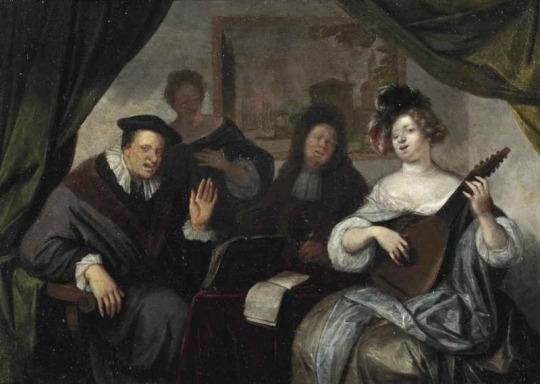
Richard Brakenburgh (1650-1702), ‘An Elegant Company making Music in an Interior’
16 notes
·
View notes
Photo
Richard Brakenburgh or Brakenburg (22 May 1650, in Haarlem – 28 December 1702, in Haarlem), was a Dutch Golden Age painter.
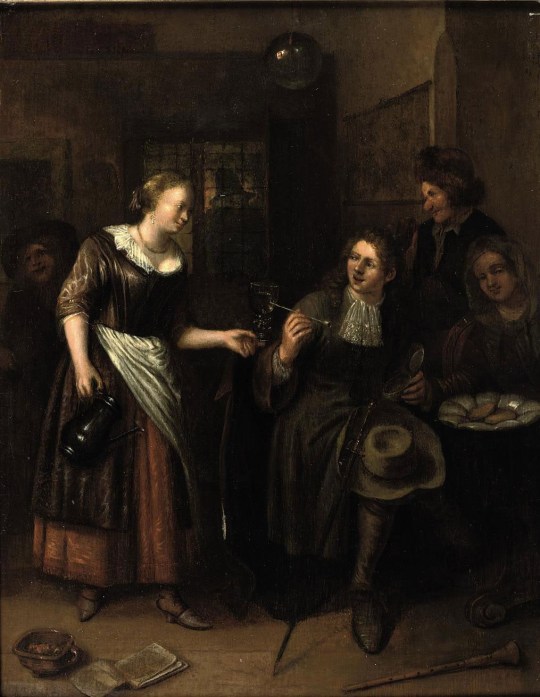
Richard Brakenburgh (1650-1702), ‘Making Merry in an Inn’
13 notes
·
View notes
Photo
Richard Brakenburgh or Brakenburg (22 May 1650, in Haarlem – 28 December 1702, in Haarlem), was a Dutch Golden Age painter.
According to Arnold Houbraken he was a light-hearted poet from Haarlem. He was the pupil of Hendrik Mommers who went on to paint clever genre scenes in the manner of Adriaen van Ostade. Though some said he was the pupil of Bernard Schendel, they were the same age and painted in similar styles. He was successful enough at his art that his Frisian widow was able to purchase an annuity after his death in Friesland.
According to the RKD he is registered in Leeuwarden during the years 1670–1687. He is known for both Italianate landscapes and portraits. He painted similar subjects to those of Schendel, representing merry-makings and drunken assemblies. His pictures are ingeniously composed, and well coloured, something in the manner of Adriaen van Ostade, though greatly inferior. They are painted with facility, although they have the appearance of being very highly finished; and he perfectly understood the management of chiaroscuro. His greatest defect is his incorrect drawing of the figure, which he appears not to have studied from nature. The Vienna Gallery has two 'Peasant Scenes' by him, said to have been painted in 1690; the Berlin Museum one, and the Amsterdam Gallery one. In the Brussels Gallery is a 'Children's Feast,' signed and dated 1698; and the Rotterdam Museum has a 'Doctor's Visit,' signed and dated 1696. In Windsor Castle are two good 'Artists' Studios ' by him. He also sometimes practised the art of engraving.
He was the teacher of Wigerus Vitringa, Abraham Pardanus, and Gillis de Winter. He was a follower of Jan Steen. He died at Haarlem in December 1702 and was buried in January 1703.

Richard Brakenburgh - Celebration of a Birth
1683
oil on panel
Dulwich Picture Gallery, London
29 notes
·
View notes
Photo
Richard Brakenburgh or Brakenburg (22 May 1650, in Haarlem – 28 December 1702, in Haarlem), was a Dutch Golden Age painter.

painting of the day: Richard Brakenburg - Feast of Saint Nicholas
12 notes
·
View notes
Photo
Richard Brakenburgh or Brakenburg (22 May 1650, in Haarlem – 28 December 1702, in Haarlem), was a Dutch Golden Age painter.
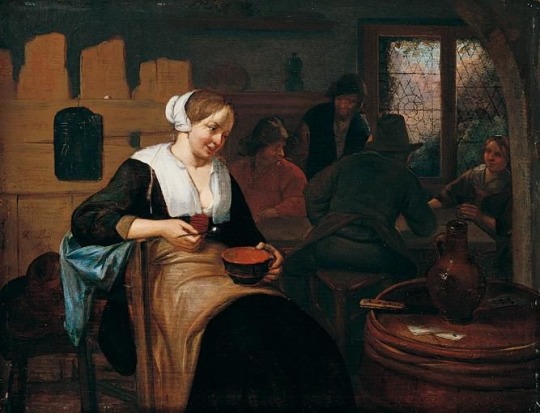
Richard Brakenburgh (1650-1702), ‘A Tavern Interior with a Lady eating a Bowl of Soup, other Figures by a Windows beyond’
18 notes
·
View notes
Text
Richard Brakenburgh or Brakenburg (22 May 1650, in Haarlem – 28 December 1702, in Haarlem), was a Dutch Golden Age painter.
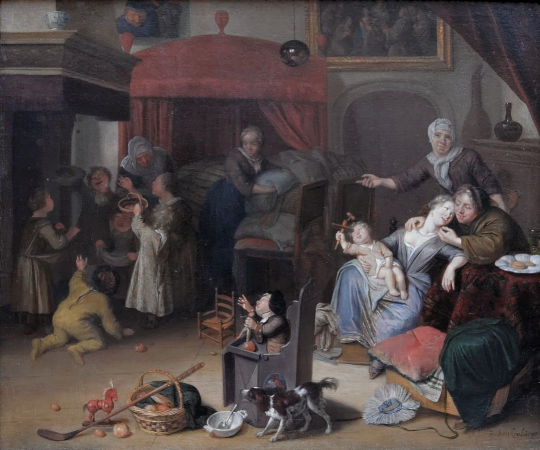
Richard Brakenburgh (1650–1702)
The Feast of Saint Nicholas
13 notes
·
View notes
Photo
Richard Brakenburgh or Brakenburg (22 May 1650, in Haarlem – 28 December 1702, in Haarlem), was a Dutch Golden Age painter.

RICHARD BRAKENBURGH
Haarlem
1650 - 1702
The Feast of St Nicholas
1685
Photo is taken by: @robertpuffjr
This 17th-century scene represents a wealthy family celebrating the typically Dutch feast of St Nicholas.
Neither St Nicholas nor his helper ‘Pete’ are depicted, which was common practice in the 17th century: the holy man stayed out of sight at the time and 'Pete’ was not introduced until the 19th century.
For this painting Brakenburg took inspiration from his predecessor Jan Steen.
Note the little boy on the left, crying because, instead of presents, he has been given the 'roe’ (birch rod) in his shoe, for bad behaviour.
In the centre we see a woman teasingly waving the boy’s shoe at him. On the right another boy is playing happily on his new drum.
(This writeup is taken from the description at the museum.)
Frans Hals Museum, Haarlem, the Netherlands
#richard #brakenburgh #richardbrakenburgh
#historyofart #artistry #greatworksofart #artmuseum #art #artist #masterpiece #painting #museumvisit #artlover #artists #artblogger (at Frans Hals Museum)
https://www.instagram.com/p/CiGxR29rXjh/?igshid=NGJjMDIxMWI=
11 notes
·
View notes
Text
Wigerus Vitringa (October 8, 1657 – January 18, 1725), was a Dutch seascape painter.
Vitringa was born in Leeuwarden. According to the RKD he was the son of a prominent lawyer who could financially permit himself a career in the arts. He was the pupil of Richard Brakenburg and possibly also the pupil of Ludolf Bakhuizen, whose style he followed. He moved to Alkmaar in the 1680s where his eyesight slowly deteriorated. He became a member of the Guild of St. Luke there in 1696. In 1708 he returned to Friesland where he became a teacher. His most notable pupil was Tako Hajo Jelgersma. Vitringa died in Wirdum.
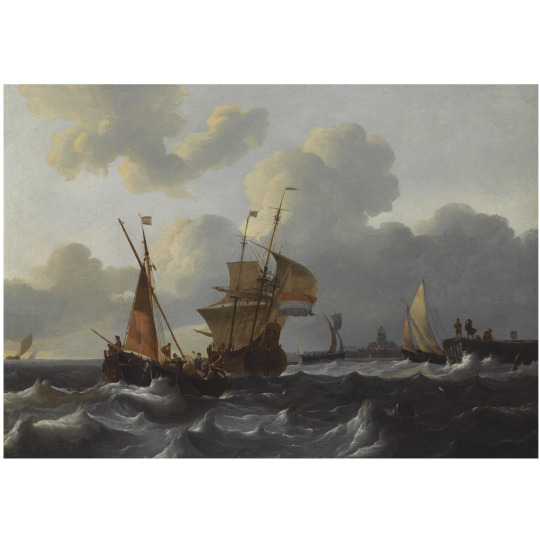
Dutch shipping in choppy waters near a Dutch village. Wigerus Vitringa Leeuwarden 1657-1725
12 notes
·
View notes
Photo
Wigerus Vitringa (October 8, 1657 – January 18, 1725), was a Dutch seascape painter.
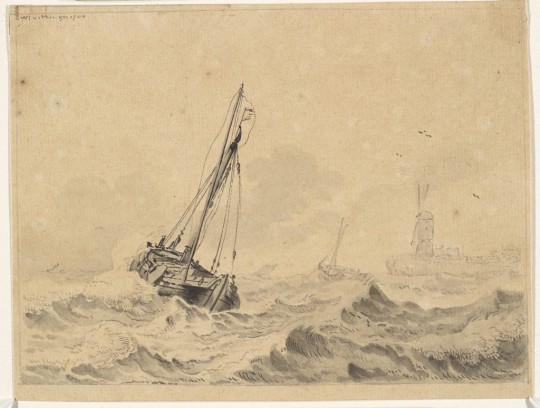
Ship at Sea, Wigerus Vitringa, c. 1700, Harvard Art Museums: Drawings
Harvard Art Museums/Fogg Museum, Bequest of Mrs. Alfred Mansfield Brooks
Size: actual: 11.2 x 14.8 cm (4 7/16 x 5 13/16 in.)
Medium: Black ink and gray wash over graphite on cream antique laid paper, autograph framing line in graphite
https://www.harvardartmuseums.org/collections/object/296222
13 notes
·
View notes
Text
Wigerus Vitringa (October 8, 1657 – January 18, 1725), was a Dutch seascape painter.
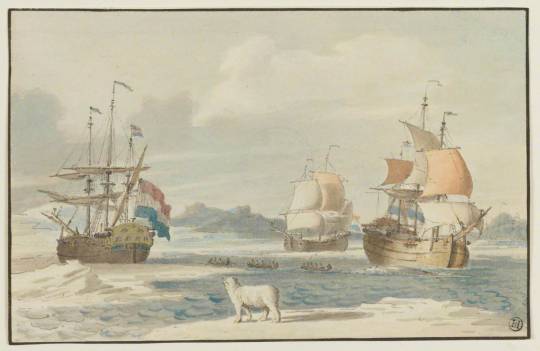
Dutch Whalers in the Arctic – Three Ships in Frozen Sea
Wigerus Vitringa (1657–1721)
The Fitzwilliam Museum
33 notes
·
View notes
Photo
Tako Hajo Jelgersma (October 29, 1702 in Harlingen – March 24, 1795 in Haarlem), was an 18th-century Dutch painter.
According to the RKD-Nederlands Instituut voor Kunstgeschiedenis, Jelgersma moved to Haarlem in 1757. He was the pupil of Frans Decker and Wigerus Vitringa. He painted landscapes, portraits, and copies of old masters. His grisailles followed the manner of Jacob de Wit. His pupils were Johan Bernard Brandhoff, Johannes Petrus van Horstok, Cornelis van Noorde, Martinus van der Jagt, and Johannes Swertner. He lived to a great age.
His pupil Cornelis van Noorde made many engravings after portraits that Jelgersma made. Often these are the only surviving portraits of these people today.
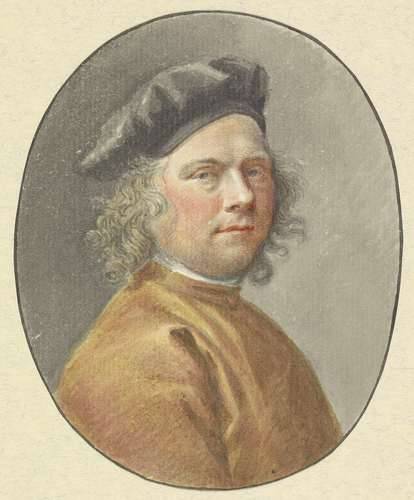
Zelfportret Tako Hajo Jelgersma, Museum of the Netherlands
http://hdl.handle.net/10934/RM0001.COLLECT.238708
10 notes
·
View notes
Text
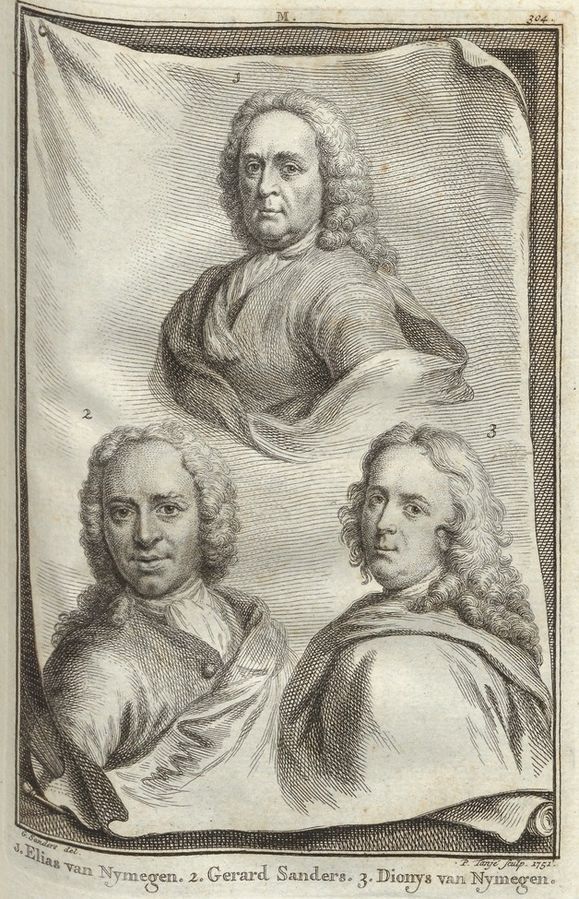
Portrait of Elias, above the engraved portraits of his pupils who were his nephew Gerard Sanders (left) and his son Dionys (right). Illustration from Jan van Gool's Nieuwe Schouburg, 1751.
Elias van Nijmegen (1667, Nijmegen – January 24, 1755, Rotterdam), was an 18th-century painter from the Northern Netherlands.
According to the RKD he became a member of the Leiden Guild of St. Luke in 1689, but he moved to Rotterdam where he married in 1701 and became a member of the guild there the next year in 1702. He is known for ceiling and wall decorations and was the teacher of the Rotterdam painters Gerard Sanders (his nephew by marriage of his brother Tobias to the widow Sanders) and his son Dionys. His daughter Barbara also became a painter.
6 notes
·
View notes
Photo
Cloelia (Ancient Greek: Κλοιλία) was a legendary woman from the early history of ancient Rome.
She was one of the women taken hostage by Lars Porsena as a part of the peace treaty which ended the war between Rome and Clusium in 508 BC. Ancient historians present two different stories explaining her escape. The first version of Cloelia's escape recognizes that the female hostages went to the river to bathe. Having persuaded their guards to leave them alone at the river, in order to remain modest, they swam across the river into Roman territory. The second version claims that Cloelia escaped from the Etruscan camp, leading away a group of Roman virgins. According to Valerius Maximus, she fled upon a horse, and swam across the river Tiber through a barrage of hostile darts, thus bringing her band of girls to safety.
Elias van Nijmegen (1667, Nijmegen – January 24, 1755, Rotterdam), was an 18th-century painter from the Northern Netherlands.
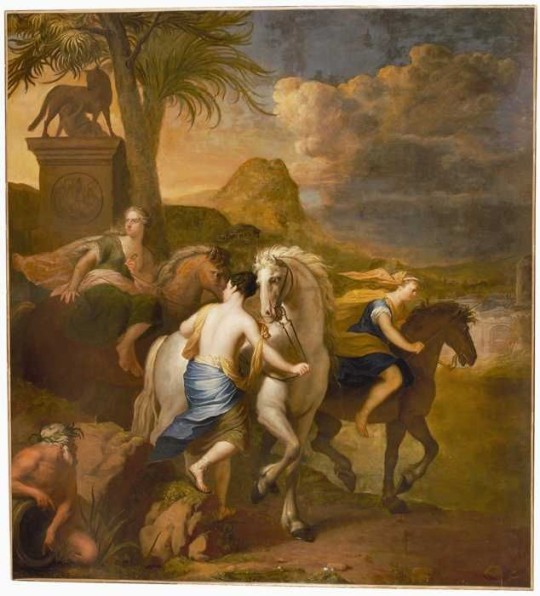
Elias van Nijmegen, 1667-1755
Cloelia on de Tiber, ca.1730/50, oil on canvas, 319x262 cm
Museum Rotterdam, Inv. 11225
34 notes
·
View notes
Photo
Elias van Nijmegen (1667, Nijmegen – January 24, 1755, Rotterdam), was an 18th-century painter from the Northern Netherlands.

Elias van Nijmegen - Perseus frees Andromeda, 1677-1755.
16 notes
·
View notes